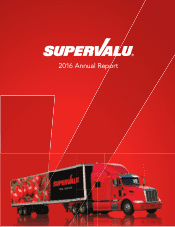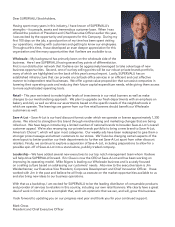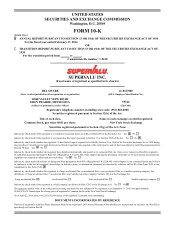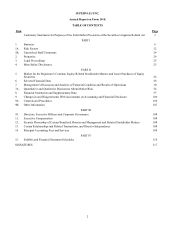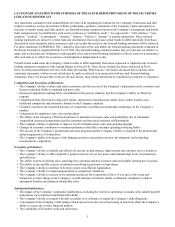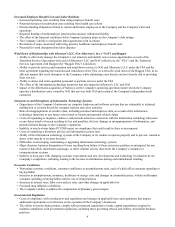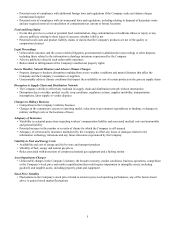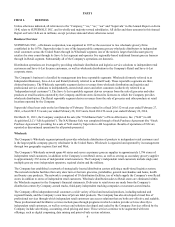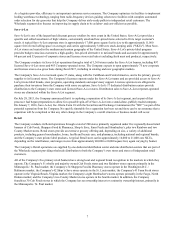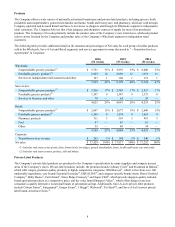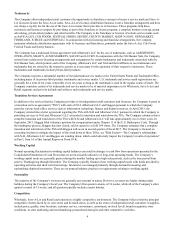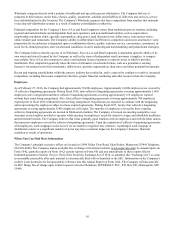Albertsons 2016 Annual Report Download - page 11
Download and view the complete annual report
Please find page 11 of the 2016 Albertsons annual report below. You can navigate through the pages in the report by either clicking on the pages listed below, or by using the keyword search tool below to find specific information within the annual report.9
Trademarks
The Company offers independent retail customers the opportunity to franchise a concept or license a service mark and Save-A-
Lot licensees license the Save-A-Lot name. Save-A-Lot's licensee distribution business is not a franchise arrangement and does
not charge a royalty fee for the use of the Save-A-Lot name that it provides to its licensees. These programs help these
customers and licensees compete by providing, as part of the franchise or license program, a complete business concept, group
advertising, private-label products and other benefits. The Company is the franchisor or licensor of certain service marks such
as SAVE-A-LOT, CUB FOODS, FESTIVAL FOODS, SENTRY, COUNTY MARKET, SHOP 'N SAVE, NEWMARKET,
FOODLAND, JUBILEE and SUPERVALU. In conjunction with its licensing and franchise arrangements, the Company
maintains wholesale distribution agreements with its licensees and franchisees, primarily under the Save-A-Lot, Cub Foods,
Festival Foods and Sentry banners.
The Company has a trademark license agreement with Albertson's LLC for the use of trademarks, such as ALBERTSONS,
JEWEL-OSCO, SHAW’S, ACME MARKETS, SAV-ON and LUCKY. In conjunction with the NAI Banner Sale, the Company
entered into certain cross-licensing arrangements and assignments for certain tradenames and trademarks associated with the
NAI Banner Sale, which permits each of the Company, Albertson’s LLC and NAI and their affiliates to use tradenames and
trademarks that are owned by the respective parties as is necessary for the operation of their respective businesses. These
tradenames and trademarks include private-label products.
The Company registers a substantial number of its trademarks/service marks in the United States Patent and Trademark Office,
including many of its private-label product trademarks and service marks. U.S. trademark and service mark registrations are
generally for a term of ten years, renewable every ten years as long as the trademark is used in the regular course of trade. The
Company considers certain of its trademarks and service marks to be of material importance to its Wholesale, Save-A-Lot and
Retail segments and actively defends and enforces such trademarks and service marks.
Transition Services Agreements
In addition to the services that the Company provides to its independent retail customers and licensees, the Company is party to
a transition services agreement ("TSA") with each of NAI, Albertson's LLC and Haggen pursuant to which the Company
provides various back-office services such as information technology, finance and human resources. In April 2015, the
Company entered into a letter agreement regarding the TSA with NAI and Albertson’s LLC pursuant to which the Company is
providing services to NAI and Albertson’s LLC as needed to transition and wind down the TSA. The Company estimates that a
complete transition and wind down of the TSA with NAI and Albertson's LLC will take approximately two to three years. In
September 2015, Haggen filed voluntary petitions for reorganization under Chapter 11 of the U.S. Bankruptcy Code. Through
the bankruptcy process, Haggen has now closed, sold or agreed to sell all 164 stores. The Company estimates that a complete
transition and wind down of the TSA with Haggen will occur in second quarter of fiscal 2017. The Company is focused on
executing its plans to mitigate the impact of the wind down of these TSAs, see "Risk Factors---The Company's relationships
with NAI, Albertson's LLC and Haggen are winding down, which could adversely impact the Company's results of operations"
in Part I, Item 1A of this Annual Report on Form 10-K.
Working Capital
Normal operating fluctuations in working capital balances can result in changes to cash flow from operations presented in the
Consolidated Statements of Cash Flows that are not necessarily indicative of long-term operating trends. The Company’s
working capital needs are generally greater during the months leading up to high sales periods, such as the time period from
prior to Thanksgiving through December. The Company typically finances these working capital needs with funds provided by
operating activities and short-term borrowings. Inventories are managed primarily through demand forecasting and
replenishing depleted inventories. There are no unusual industry practices or requirements relating to working capital.
Seasonality
The majority of the Company's revenues are generally not seasonal in nature. However, revenues are higher during major
holidays during the Company's fiscal year. The Company's first quarter consists of 16 weeks, while all of the Company's other
quarters consist of 12 weeks, and all quarters typically include a major holiday.
Competition
Wholesale, Save-A-Lot and Retail each operate in a highly competitive environment. The Company believes that the principal
competitive factors faced by its own stores and licensed stores, as well as the stores of independent retail customers it supplies,
include price, quality, store locations, customer service, convenience, assortment, in-stock levels, brand recognition, store
conditions, in-store marketing and merchandising, promotional strategies and other competitive activities.

